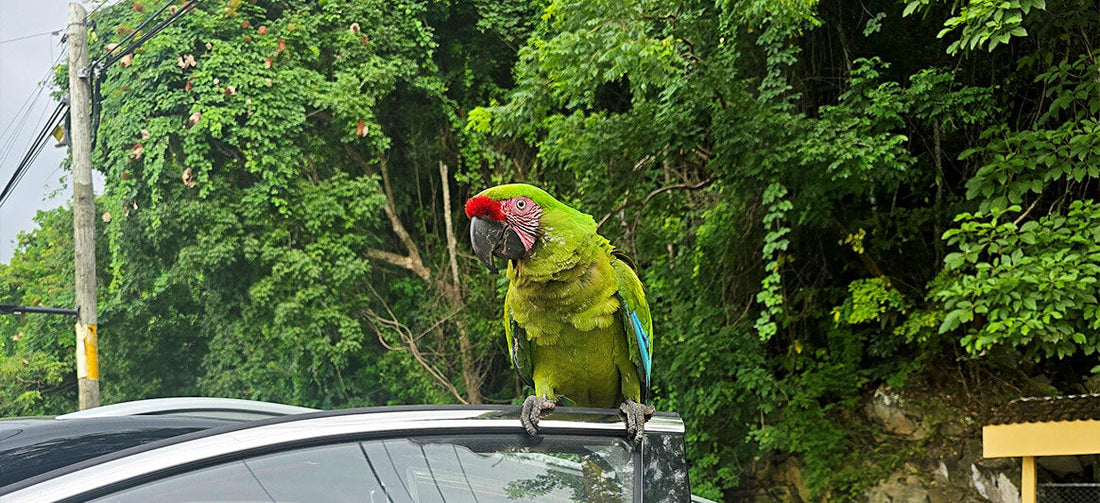
Guardians of the Green: The Military Macaw in Coastal Jalisco
In the lush coastal forests of Jalisco, Mexico, along the shores of the Pacific and tucked into the foothills and near our home in Mismaloya flies one of the region’s most magnificent and vulnerable residents: the Military Macaw (Ara militaris), sometimes called the Green Macaw. Vibrant, intelligent, and deeply tied to its habitat, this bird is as much a symbol of natural richness as it is a bellwether of ecological health.
This one pictured above has become highly domesticated and visits a local restaurant and convenience store to socialize and receive treats. We were lucky enough to encounter him at our local Oxxo convenience store where this picture was taken. Below is a bit more information on this spectacular bird.
The Military Macaw?
The military macaw is a large, long-tailed parrot. Its plumage is overall green, with blue on parts of the wings and back, flashes of red in the tail and forehead, and white, lightly feathered areas around the face. It is sometimes noted that its name comes from its coloring—reminiscent of military uniform hues. The bird is social, very intelligent, forming strong pair bonds that last, and can live for many decades in suitable habitat.
Habitat & Behavior Along Jalisco’s Coast
Coastal Jalisco, especially regions like Bahía de Banderas and Cabo Corrientes, offers several kinds of forest that this macaw depends on: tropical dry forest, sub-deciduous forest, semi-deciduous patches, and riparian areas among steep terrain. These forests provide both nesting sites and feeding grounds. The macaws often use cliffs or tall trees for nests, and forage across forest patches with high diversity of edible trees and plants.
A 2018 population assessment in the southern coastal forests of Bahía de Banderas found that there are several distinct groups (flocks) of military macaws that use different areas for nesting, roosting, or feeding, sometimes moving seasonally. In one of these groups, a roost in the Yelapa region had as many as 215 macaws during certain times, among the largest aggregations documented in this species locally.
Threats: A Vanishing Canopy
Despite its resilience, the military macaw is under serious threat in Jalisco. The primary dangers are:
- Habitat Loss and Fragmentation: Tropical dry forest—the backbone of the macaw’s range along the coast—has been reduced significantly. Farming, development, and roads chop up what were once continuous forests, making it harder for macaw groups to find enough food, suitable nesting trees, and to safely move across the landscape.
- Illegal Capture for the Pet Trade: A long‐standing—and still active—threat. Macaws are prized for their beauty and intelligence, and poachers continue to take eggs, chicks, or even adult birds for sale. This is especially damaging in small, isolated populations.
- Low Population Numbers & Isolation: Many groups in Jalisco have fewer than a few hundred individuals; some are quite small, and the separation between forest patches means reduced genetic exchange and increased vulnerability.
Conservation Efforts
Thankfully, there are several inspiring efforts underway:
- Sanctuaries & Nesting Box Programs: For example, the Santuario de las Guacamayas in Cabo Corrientes is installing and managing artificial nest boxes, reforesting critical habitat patches, and has already had dozens of fledglings leave the nest successfully.
- Monitoring & Scientific Studies: Research is being done on which forest patches are used by macaws (versus those that are avoided), what kinds of trees they need, how they move seasonally, and how large the local populations are. The information from the population assessment of Bahía de Banderas, for example, is helping to define priority areas for protection.
- Community Engagement & Ecotourism: Some projects, supported by organizations like Loro Parque Fundación, aim to combine conservation with sustainable local development. By involving local people in protecting nesting trees, maintaining forest cover, and perhaps through guided birdwatching, these programs seek both ecological and economic benefits.
Why It Matters
The military macaw is not just beautiful; it plays a key ecological role. As a seed disperser and frugivore, it helps maintain forest health. Its presence indicates functioning forest ecosystems with large trees, minimal disturbance, and connectivity. For local communities, its well-being is tied to water quality, soil stability, and the broader environmental services that intact forests provide.
Also, culturally, seeing wild macaws, hearing their calls at dawn, witnessing flocks winging overhead, connects people to wild nature in a visceral way. In regions heavily impacted by deforestation and land-use change, such connections matter.
What You Can Do
- Support conservation groups such as those working in Jalisco that are protecting habitat, installing nest boxes, and educating communities.
- Promote and participate in sustainable ecotourism such as bird watching and guided forest hikes in ways that respect wildlife and incentivize preservation.
- Raise awareness about the illegal pet trade.
- Encourage forest restoration: planting native trees, preserving forest fragments, and advocating for land‐use practices that leave canopy trees standing.
Conclusion
The Military Macaw in coastal Jalisco is both a jewel of the natural world and a sensitive indicator that tells us much about the health of the forests. Its bright plumage lights up green canopy, but its declining numbers warn of loss if we do not act. With scientific knowledge, committed protection, and a growing awareness in local communities and among visitors, there remains hope that the skies over Jalisco will continue ringing with their calls for generations to come.
